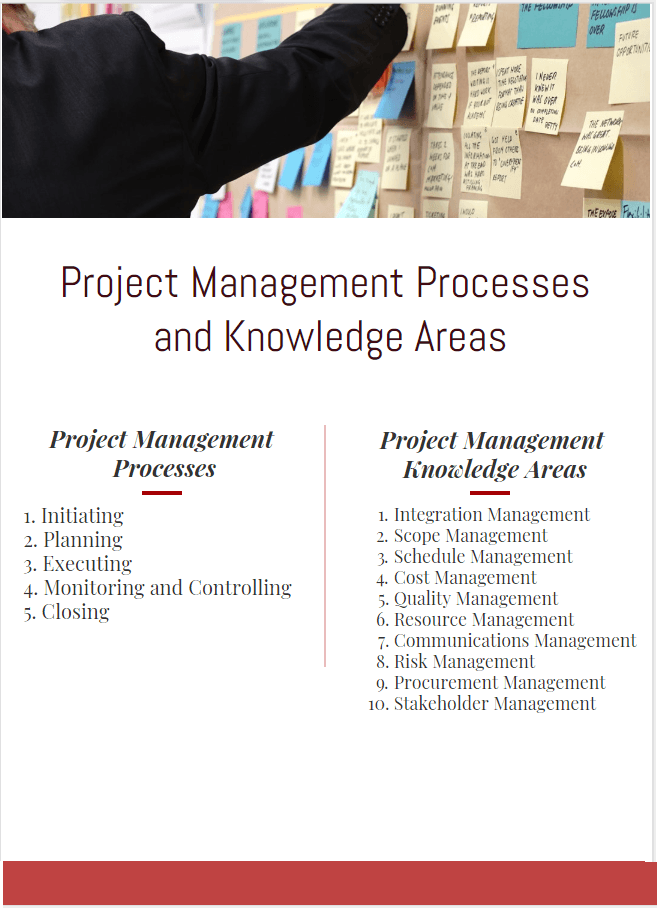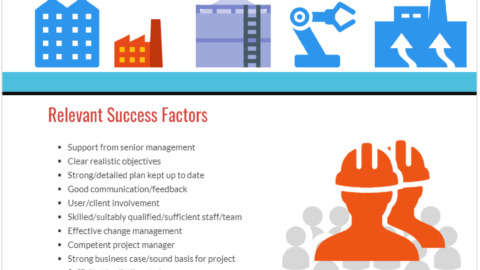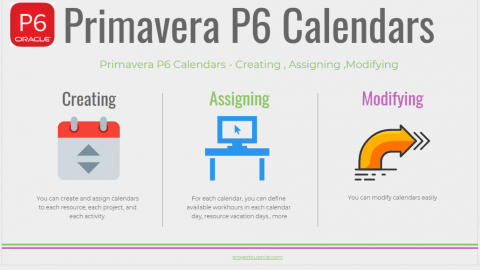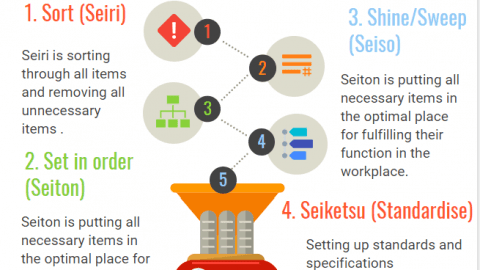Project Management Processes and Knowledge Areas
PMP aspirants usually ask these common questions while preparing for the PMP Certification Exam: What are the project management processes? What are the project management knowledge areas? Why do we need these project management process groups and knowledge areas?
Table of Contents
They often have difficulties in understanding these important concepts. In this article, we will take a glance at both concepts and clarify their differences.
The project management process groups are related to defining, organizing, and managing the scope of the project.
In order to understand better, let’s define the “project” and “project management” terms.
Project and Project Management
A project is a temporary and unique operation that is designed to accomplish a singular goal. It has defined scope and resources.
Software development, a business process improvement, and expansion of sales in a new market and dam construction are the samples of projects.
All the projects must be managed to deliver on time and budget with meeting the organizational goals.
Project management is the implementation of processes, knowledge areas, talents, techniques, and methods to project tasks in order to achieve the project’s goals. Project management has several dimensions based on the type and magnitude of the project.
In brief, project management is the method of selecting, organizing, planning, managing, and controlling resources to meet the project’s requirements.
Project Management Processes (Process Groups)
Project management process groups are a logical classification of tasks that are arranged in a system that the projects are being performed. The Project Management Institute created terminologies and guidelines to help you to successfully manage your project that is known as project management process groups and knowledge areas.
According to PMBOK Guide, Project management has five interrelated processes;
1. Initiating
2. Planning
3. Executing
4. Monitoring and Controlling
5. Closing
An idea for a project will be analyzed considering its benefits and incomes for the stakeholders during the initiating process. The initiating process includes developing and approving the project charter.
The planning process includes creating the project management plan that helps to execute project activities. Project schedule, budget, and resources are determined during the planning process.
The executing phase is usually the longest phase in the project life cycle in which the physical project deliverables will be built and presented to the client. During the executing process, you perform the actual work and spend most of the time and money.
In the monitoring and controlling phase, project management teams will compare and report the planned and the actual status of the project. During this phase, project managers will make adjustments to keep the project on track. It is a continuous process that happens throughout the project life cycle.
The closing phase comes after the completion of all the scope of work and project management processes. The closing process is a formal process that includes the formal agreement of completion of the project between the parties. You close all procurement contracts and update the lessons learned during the closing process.
As you see from the above, all the process groups are organized in order. All the five process groups; Initiating, Planning, Executing, Monitoring and Controlling, Closing are needed to complete the project successfully.
Although project types and project management processes vary from industry to industry, the above project management phases are traditional phases for almost all projects.
Project Management Knowledge Areas
The PMBOK Guide defines ten knowledge areas for successful project management. These project management knowledge areas bring the project to life and ensure that the project meets its objectives.
1. Project Integration Management
2. Project Scope Management
3. Project Time Management
4. Project Cost Management
5. Project Quality Management
6. Project Procurement Management
7. Project Human Resources Management
8. Project Communications Management
9. Project Risk Management
10. Project Stakeholder Management
1. Project Integration Management
Project integration management aims at keeping the whole project together by including essential documents such as a project charter. A project charter constitutes the project with assigning the project manager.
A project management plan which is one of the most important documents of this area creates the roadmap for the project to guide everybody involved. Project integration management also aims at running and managing the project work.
2. Project Scope Management
The scope is the work to be done to complete the project. In order to define the scope, you need to collect the requirements and detail the features of the final product in a scope statement. Creating the WBS (Work Breakdown Structure) which breakdowns the project work into smaller and manageable sections is a fundamental step of this area.
Monitoring and controlling the scope process includes accepting the deliverables and validating the scope during the course of the project.
3. Project Time Management
Every project has specific start and end dates. Time is an important input for any process. Once the WBS (Work Breakdown Structure) is created, activities are detailed under each WBS level. Each activity has start and finish dates, as well as resources and budget.
The plan schedule management process includes developing the project schedule by determining the activities and task lists. Logical links and relationships between the activities are established to represent the workflow.
After creating the schedule, the next step is estimating and assigning the resources. The working calendar of each resource should be specified at this step.
Finally, the critical path is calculated, and float for each task should be analyzed in order to make sure that the schedule is well created.
Once the schedule is created, the monitoring and controlling phase comes where you make earned value calculations to understand the performance of the schedule.
4. Project Cost Management
The project cost management area includes creating, monitoring, controlling, and reporting the project budget to make sure that the funds cover the extent of the project. Informing the stakeholders and the project sponsor regarding the budget is key to receive their support when needed.
During the plan cost management process, you decide the method to create the project budget and procedures to control it. For an effective budget, the cost of each task should be estimated in detail by calculating the quantities of resources such as material, workforce, and equipment.
This will determine the project budget, once you take all the task costs and combine them. Then comes the need to control those cost through an earned value analysis. This is performed regularly throughout the project to make sure the estimated costs are in line with actual expenditures.
Once you complete the project budget, the monitoring and controlling process comes in which you make earned value calculations to determine cost overruns.
5. Project Quality Management
Without fulfilling the quality requirements, a project can not be accomplished. In the overall project management plan, plan quality management has an important place.
Project Quality Management includes quality assurance works to ensure that quality standards are being met. In order to control the quality, the deliverables of the project should be inspected to ensure that the
Therefore, to control quality, the deliverables must be inspected to make sure that those specifications defined in the quality management plan are being met.
6. Project Procurement Management
Project procurement management includes efforts to procure goods, services and hire subcontractors to successfully deliver the project. Procurement works affect both project budget and schedule.
During the planning procurement management, you determine the outside requirements of the project and the subcontractor’s involvement.
Project procurement management includes defining the statement of work, terms of reference, and request for proposals while hiring subcontractors.
7. Project Human Resources Management
A project can not be carried out without managing the project’s resources successfully. Creating the project team and tracking their performance is subject to human resources management. In order to facilitate the processes, a human resource management plan which specifies the roles and involvements of the positions is created.
After determining the role of each position, you begin with employing the team members. You can pull team members from other projects either inside or outside the organization.
Managing the team is an ongoing process in which you monitor and control their performance and resolve the conflicts between them.
8. Project Communications Management
Project communications management is one of the most important areas in the success of any project. Within a project, communication is the exchanging of information between the team and stakeholders in different forms.
Communications inform the team and stakeholders, therefore the need to plan communications management is a critical step in any project.
The communications management plan which is the output of the plan communications process determines how the communications will be conducted between the parties. The aim of monitoring and controlling communications is to review the process and make adjustments when needed.
9. Project Risk Management
The objective of creating a risk management plan is to identify, categorize and prioritize project risks that might arise during the course of the project.
Risk analysis is performed after the identification and classification of project risks. It is done to develop strategies to deal with risks.
Monitoring and controlling risks includes analyzing the risk register and evaluating risks to understand their potential impacts on the project.
10. Project Stakeholder Management
Projects are carried out to fulfill the requirements of the stakeholders. So, they must be pleased with the outcomes of the project. Therefore, the stakeholders must be actively determined, analyzed, and managed to understand what their concerns are.
Plan stakeholder management includes prioritizing and classifying stakeholders according to their impact to successfully engage the stakeholders throughout the entire project’s life cycle. The control stakeholder management process focuses on stakeholder engagement and adjusts their expectations.
These ten project management knowledge areas provide a direction to organize and classify the knowledge and skills required in a particular specialty in project management. Processes and tasks are grouped into common areas. By grouping many project management processes and tasks into a few areas, it’s easier to know and recognize.
The process groups are grouped under the knowledge areas based on their similarities on the subject. The PMBOK Guide and most of the reference books available for the PMP certification exam are organized based on these ten knowledge areas. However, there are some reference books that are written based on the process groups. If you read both of them, you will gain a better understanding of the project management processes and knowledge areas.
Conclusion
Project management has evolved from a few simple practices to a wide subject with many complex processes and knowledge areas. Following an established project management methodology helps project managers to complete their projects successfully. Most of these methodologies follow specific processes. The PMBOK Guide is a strong reference book that is a collection of processes, practices, terminologies, and knowledge areas. Gaining expertise in all of these knowledge areas can help project managers to become more successful in their organizations. Project managers need to know each of the processes and have the skills to accomplish their tasks.
In this article, we discuss the project management processes and project management knowledge areas. We hope that it will be useful for the PMP aspirants. Please note that this is an important topic for the PMP Certification Exam. Therefore you must know the knowledge areas and processes in each process group in order to pass the exam. If you have something to add or share, you can do so by using the comments section below.
External References
[1] What is Project Management (pmi)

Director at HST Systems Limited
Since 2009 I have been working as a project management professional. I am passionate about new technologies, i have the privilege to implement many new systems and applications for my company.











very useful information ive gotten from you thanks